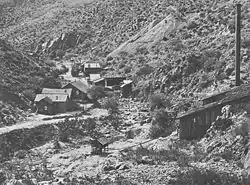Tip Top, Arizona
Tip Top is a ghost town in Yavapai County in the U.S. state of Arizona. The town was settled in 1876 in what was then the Arizona Territory.
Tip Top, Arizona | |
|---|---|
 Northern end of Tip Top, circa 1888 | |
 Tip Top, Arizona Location in the state of Arizona  Tip Top, Arizona Tip Top, Arizona (the United States) | |
| Coordinates: 34°03′03″N 112°14′49″W | |
| Country | United States |
| State | Arizona |
| County | Yavapai |
| Founded | 1876 |
| Abandoned | 1895 |
| Elevation | 2,510 ft (765 m) |
| Population (2009) | |
| • Total | 0 |
| Time zone | UTC-7 (MST (no DST)) |
| Post Office opened | August 12, 1880 |
| Post Office closed | February 14, 1895 |
History
Primarily a silver-mining town, it had a post office from August 12, 1880, until February 14, 1895. The town was founded after Jack Moore and Bill Corning struck a significant lode of silver in 1875.[2][3]
The nearby ghost town of Gillett was the original mill site for the ore from the Tip Top mine.
Tip Top at its peak had over 500 residents and was one of the largest towns in Arizona at the time.
Tip Top's population was 65 in 1890.[4]
Many ruins still exist in Tip Top today.
Tip Top is the setting for The Nightjar Women, the last story in the weird western anthology Merkabah Rider: Tales of a High Planes Drifter by Edward M. Erdelac.

References
- U.S. Geological Survey Geographic Names Information System: Tip Top (historical)
- Sherman, James E.; Barbara H. Sherman (1969). "Tip Top". Ghost Towns of Arizona (First ed.). University of Oklahoma Press. pp. 151–152. ISBN 0-8061-0843-6. Retrieved January 13, 2014.
- Arizona Days and Ways, September 11, 1966
- Cram, George Franklin (1890). Cram's Universal Atlas: Geographical, Astronomical and Historical, Containing a Complete Series of Maps of Modern Geography, Illustrated by Numerous Views and Charts; the Whole Supplemented with Valuable Statistics, Diagrams, and a Complete Gazetteer of the United States. G.F. Cram. p. 368.
External links
 Media related to Tip Top, Arizona at Wikimedia Commons
Media related to Tip Top, Arizona at Wikimedia Commons Ghost towns travel guide from Wikivoyage
Ghost towns travel guide from Wikivoyage- Tip Top on Ghosttowns.com
- Tip Top on Arizona Pioneer & Cemetery Research Project
- Tip Tip on the Ghost Town of the Month
